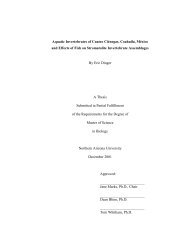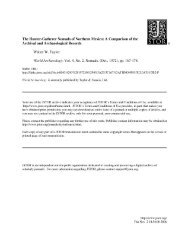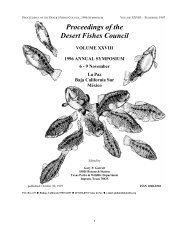Proceedings of the Desert Fishes Council 2000
Proceedings of the Desert Fishes Council 2000
Proceedings of the Desert Fishes Council 2000
You also want an ePaper? Increase the reach of your titles
YUMPU automatically turns print PDFs into web optimized ePapers that Google loves.
PROCEEDINGS OF THE DESERT FISHES COUNCIL - VOLUME XXX1I (<strong>2000</strong> SYMPOSIUM) – PUBLISHED NOVEMBER 13, 2001<br />
Pesquera, un informe que contiene toda la información básica sobre especies exóticas y endémicas para cada una<br />
de 10 regiones, y que se supone habrá de regular las pesquerías y la acuacultura. Contiene definiciones,<br />
sugerencias sobre uso legal y explotación, amenazas a los recursos, y en particular la recomendación de no<br />
introducir más especies acuáticas, y controlar la contaminación. Aunque no ha sido aprobada, por lo menos los<br />
niveles altos del gobierno han recibido este mensaje importante. Si las recomendaciones aparecen en la versión<br />
final, se convertirán en el instrumento de regulación de las pesquerías y la acuacultura. Debiéramos felicitar a la<br />
Dirección General de Investigaciones en Acuacultura, SEMARNAP [ahora SEMARNAT], por su compilación.<br />
Está lista para impresión la versión final del reporte al WWF sobre las prioridades de conservación del Desierto<br />
de Chihuahua. Acaba de ser publicado otro libro interesante: R. Claudi y J.H. Leach, <strong>2000</strong>, Nonindigenous<br />
Freshwater Organisms, Vectors, Biology and Impacts [Organismos Dulceacuícolas No-nativos, Vectores,<br />
Biología e Impactos]; Lewis Publishers. Del 9 al 11 de noviembre se llevó a cabo la reunión de ONGs “Uniendo<br />
la Cuenca”, organizada por la “Coalition for Sustainable Development <strong>of</strong> <strong>the</strong> Rio Grande/Río Bravo Basin”<br />
[Coalición para el Desarrollo Sostenible de la Cuenca del Río Grande /Río Bravo]. Los detalles, más adelante.<br />
Hubbs, C<br />
(University <strong>of</strong> Texas, Integrative Biology)<br />
Effect <strong>of</strong> feeding regime on Gambusia cannibalism<br />
ABSTRACT<br />
Gambusia has a reputation for a high rate <strong>of</strong> cannibalism in <strong>the</strong> aquarium literature. In contrast, tests with<br />
well-fed fish show much lower cannibalism. A series <strong>of</strong> tests were run with new-borns exposed to adults fed<br />
daily, every two days, four days, or six days. Those fed daily had much higher survival than those fed<br />
infrequently. Much higher survival occured with young in aquaria without predators, showing that starvation <strong>of</strong><br />
young was not <strong>the</strong> cause for <strong>the</strong> differential survival with adults.<br />
RESUMEN<br />
Efecto del régimen alimenticio en el canibalismo de Gambusia<br />
A Gambusia se le reconoce por su elevada tasa de canibalismo en la literatura de acuarios [peces de ornato].<br />
Por el contrario, en pruebas con peces bien alimentados se registró mucho menor canibalismo. Se realizó una<br />
serie de pruebas con peces recién nacidos expuestos a adultos alimentados diariamente, cada dos, cuatro o seis<br />
días. Los alimentados a diario mostraron una supervivencia mucho mayor que los alimentados con baja<br />
frecuencia. La supervivencia de juveniles fue mucho mayor en acuarios sin depredadores, indicando que la<br />
inanición de juveniles no fue la causa de la supervivencia diferencial con adultos.<br />
Vredenburg, VT<br />
(Univ. <strong>of</strong> California, Dept. <strong>of</strong> Integrative Biology and Museum <strong>of</strong> Vertebrate Zoology)<br />
Exotic species and <strong>the</strong> decline <strong>of</strong> amphibians: unintended consequences on a global scale<br />
ABSTRACT<br />
A puzzling aspect <strong>of</strong> amphibian declines is that amphibians, particularly frogs, have been declining even in<br />
large protected areas. These habitats are generally thought to be relatively unaltered and undisturbed. However,<br />
<strong>the</strong> introduction <strong>of</strong> nonnative fishes is a common practice throughout <strong>the</strong> world, and may be an important cause<br />
<strong>of</strong> declines. In <strong>the</strong> Sierra Nevada, California, <strong>the</strong> mountain yellow-legged frog has disappeared from >80% <strong>of</strong> its<br />
historic habitat during <strong>the</strong> past century. We used a survey <strong>of</strong> >1700 naturally fishless lakes and ponds in two<br />
large protected areas to describe <strong>the</strong> distribution <strong>of</strong> nonnative trout and mountain yellow-legged frogs. This<br />
survey indicated that <strong>the</strong> distributions <strong>of</strong> introduced trout and mountain yellow-legged frogs were nonoverlapping.<br />
To test <strong>the</strong> hypo<strong>the</strong>sis that introduced trout were driving this pattern, a fish-removal experiment<br />
was conducted over a four-year period. Frogs quickly recolonized <strong>the</strong> fish-removal lakes from nearby source<br />
populations, while numbers <strong>of</strong> frogs in fish-containing control lakes remained low and constant. These data<br />
29



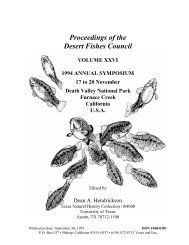
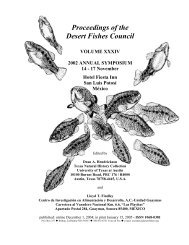
![Part 2 [419KK] - Desert Fishes Council](https://img.yumpu.com/14712282/1/190x245/part-2-419kk-desert-fishes-council.jpg?quality=85)

